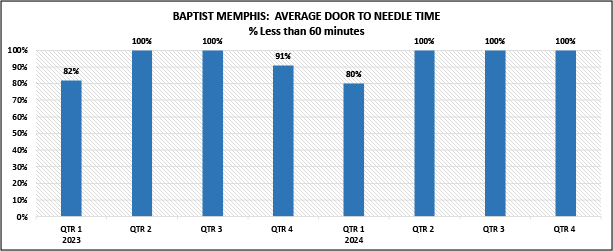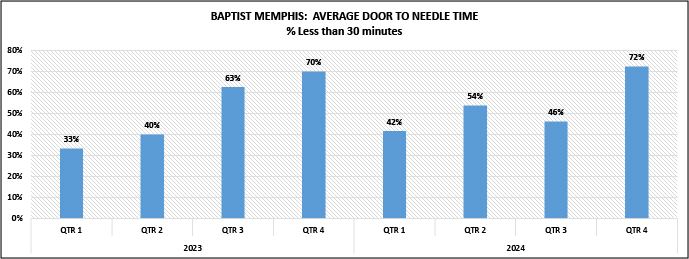Stroke Outcomes for Patients
Baptist is a leader in responsive, effective stroke care
When a stroke occurs, every minute counts. The stroke specialists at Baptist know that immediate response times, attention to quality patient care, and appropriate treatment decisions can make all the difference in our patient outcomes. That is why we rely on specific data to measure our performance against established standards, and in comparison to others when it comes to timely assessment, decision-making and best treatment options.
We're proud to say that Baptist stroke services outpace those industry standards and the performance of other health care providers. Baptist utilizes advanced technology and imaging capabilities to quickly identify those patients who meet the guidelines to have an intervention. The quicker the intervention and the faster blood flow is restored, the less likely the patient will have short or long-term disabilities.
The following information shows our performance goals and how we measure up to them, and other stroke care providers, in terms of treating the cause of the stroke (thrombolysis) and restoring blood flow to the brain and other organs (reperfusion), specifically in the areas of:
- Hemorrhagic Transformation (overall rate)
- Thrombolysis in Cerebral Infarction (tici) post-treatment reperfusion grade
- Rate of rapid effective reperfusion from hospital arrival
- Rate of rapid effective reperfusion from skin puncture
- IV Thrombolytic: Arrive within 3.5 hours and treat by 4 hours
- Time of intravenous thrombolytic therapy 60 minutes or less
- Time of intravenous thrombolytic therapy 30 minutes or less
Baptist uses Get With The Guidelines® (GWTG) from the American Heart Association and the American Stroke Association for the data registry. GWTG is the leader for driving hospital quality improvements.
While our outcomes are strong compared with our peers, our team of specialty-trained physicians, nurses and staff carefully review the results of each patient to continually identify ways to improve the care Baptist provides.
Hemorrhagic Transformation (Overall Rate)
| January 2023 - December 2024 |
| WHAT DOES THIS MEAN? |
| This is the percentage of patients who are treated for stroke using a thrombolytic or an endovascular procedure that had a hemorrhagic transformation (bleeding post treatment) |
| 2023 Q1 |
2023 Q2 |
2023 Q3 |
2023 Q4 |
2024 Q1 |
2024 Q2 |
2024 Q3 |
2024 Q4 |
|
| Baptist Memphis | 0% | 0% | 0% | 0% | 0% |
0% |
0% | 0% |
Rate of Rapid Effective Reperfusion from Hospital Arrival
| January 2023 - December 2024 |
| WHAT DOES THIS MEASURE? |
| This is the percentage of patients who have successful blood flow restoration within 120 minutes or less of hospital arrival. |
| 2023 Q1 |
2023 Q2 |
2023 Q3 |
2023 Q4 |
2024 Q1 |
2024 Q2 |
2024 Q3 |
2024 Q4 |
|
| Baptist Memphis | 67% | 65% | 62% | 50% | 58% | 82% | 50% | 67% |

Rate of Rapid Effective Reperfusion from Skin Puncture
| January 2023 - December 2024 |
| WHAT DOES THIS MEASURE? |
| Percentage of patients who have successful blood flow restoration within 60 minutes or less of procedure time. |
| 2023 Q1 |
2023 Q2 |
2023 Q3 |
2023 Q4 |
2024 Q1 |
2024 Q2 |
2024 Q3 |
2024 Q4 |
|||||
| Baptist | 71% | 50% | 62% | 62% | 65% | 75% | 67% | 65% | ||||

IV Thrombolytic: Arrive within 3.5 hours and Treat by 4 hours
| January 2023 - December 2024 |
| WHAT DOES THIS MEASURE? |
| Percentage of patients that arrive at the hospital within 3.5 hours of symptom onset for whom treatment with IV medications was initiated within 4.5 hours. |
| 2023 Q1 |
2023 Q2 |
2023 Q3 |
2023 Q4 |
2024 Q1 |
2024 Q2 |
2024 Q3 |
2024 Q4 |
|
| Baptist Memphis | 100% | 100% | 100% | 100% | 100% | 100% | 100% | 100% |

Time of Intravenous Thrombolytic Therapy 60 minutes or less
| January 2023 - December 2024 |
| WHAT DOES THIS MEAN? |
| This is the time from the patient's arrival until the patient receives IV Thrombolytics in 60 minutes or less |
| Goal: Less than 45 minutes |
| 2023 Q1 |
2023 Q2 |
2023 Q3 |
2023 Q4 |
2024 Q1 |
2024 Q2 |
2024 Q3 |
2024 Q4 |
|
| Baptist Memphis | 82% | 100% | 100% | 91% | 80% | 100% | 100% | 100% |

Time of Intravenous Thrombolytic Therapy 30 minutes or less
| January 2023 - December 2024 |
| WHAT DOES THIS MEAN? |
| This is the time from the patient's arrival until the patient receives IV Thrombolytics in 30 minutes or less |
| Goal: Less than 30 minutes |
| 2023 Q1 |
2023 Q2 |
2023 Q3 |
2023 Q4 |
2024 Q1 |
2024 Q2 |
2024 Q3 |
2024 Q4 |
|
| Baptist Memphis | 33% | 40% | 63% | 70% | 42% | 54% | 46% | 72% |

Carotid Endarterectomy
Carotid arteries are on either side of your neck. They are the large blood vessels that carry blood to your brain. When carotid arteries become blocked or narrower, the blood flow cannot feed the brain blood. The brain requires oxygen that is in blood. The brain suffers an injury without adequate blood flow.
A major risk factor associated with stroke is carotid artery disease caused by plaque or fatty deposits (cholesterol) in the carotid artery. Carotid artery stenosis refers to the narrowing of the carotid arteries.
High blood pressure, tobacco use, diabetes, high cholesterol or fat in the blood and even sleep apnea can damage the carotid arteries. One of the treatments for severe carotid artery stenosis is Carotid Endarterectomy. The surgical procedure involves the surgeon opening the blocked carotid artery and removing the fatty deposits/plaques.
Carotid Endarterectomy Complications/Mortality Data:
| Month/Year | Complications | Deaths |
| January 2023 - December 2024 | 4 | 0 |
| Total % | 5.13% | 0% |


